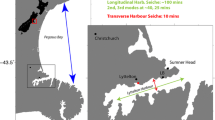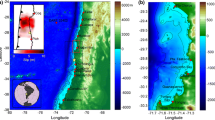Abstract
The Gulf of Cadiz coasts are exposed to tsunamis. Emergency planning tools are now taking into account this fact, especially because a series of historical occurrences were strikingly significant, having left strong evidence behind, in the mareographic records, the geological evidence or simply the memory of the populations. The study area is a strip along the Algarve coast, south Portugal, an area known to have been heavily impacted by the 1 November 1755 event. In this study we use two different tsunami scenarios generated by the rupture of two thrust faults identified in the area, corresponding to 8.1–8.3 magnitude earthquakes. Tsunami propagation and inundation computation is performed using a non-linear shallow water code with bottom friction. Numerical modeling results are presented in terms of flow depth and current velocity with maximum values of 7 m and 8 m/s for inundation depth and flow speed, respectively. These results constitute a valuable tool for local authorities, emergency and decision planners to define the priority zones where tsunami mitigation measures must be implemented and to develop tsunami-resilient communities.








Similar content being viewed by others
References
Aki, K. (1966), Earthquake mechanism, Tectonophysics 13(1–4), 423–432.
Baptista, M.A., Miranda, P.M.A., Mendes-Victor, L. (1992), Maximum entropy analysis of Portuguese tsunamis: The tsunamis of 28/02/1969 and 26/05/1975, Sci. Tsunami Hazards, 10(1), 9–20.
Baptista, M.A., Heitor, S., Miranda, J.M., Miranda, P., and Mendes-Victor, L. (1998a), The 1755 Lisbon tsunami; evaluation of the tsunami parameters, J. Geodynamics 25, 143–157.
Baptista, M.A., Miranda, P.M.A., Miranda, J.M., and Mendes-Victor, L. (1998b), Constraints on the source of the 1755 Lisbon tsunami inferred from numerical modeling of historical data on the source of the 1755 Lisbon tsunami, J. Geodynamics 25, 159–174.
Baptista, M.A., Miranda, J.M., Chirericci, F., and Zitellini, N. (2003), New Study of the 1755 Earthquake Source Based on Multi-channel Seismic Survey Data and Tsunami Modeling, Nat. Hazards Earth Syst. Sci. 3, 333–340. http://www.nat-hazards-earth-syst-sci.net/3/333/2003/nhess-3-333-2003.html.
Baptista, M.A., Miranda, J.M., Lima, V., Catalão, J., and Roquete, P. (2008), Technical Report: Estudo do Risco Sísmico e de Tsunamis no Algarve. Contract research to ANPC – Autoridade Nacional de Protecção Civil, Portugal. (in Portuguese).
Baptista, M.A., and Miranda, J.M. (2009), Revision of the Portuguese catalog of tsunamis, Nat. Hazards Earth Syst. Sci. 9, 25–42. http://www.nat-hazards-earth-syst-sci.net/9/25/2009/nhess-9-25-2009.html
Bondevik, S., Mangerud, J., Dawson, S., Dawson, A.G., and Lohne, O. (2003), Record-breaking height for 8000 years-old tsunami in the North Atlantic. EOS, 84: 289–300.
Bondevik, S., Løvholt, F., Harbitz, C., Mangerud, J., Dawson, A., and Svendsen, J.I. (2005), The Storegga slide tsunami – Comparing field observations with numerical simulations. Marine and Petroleum Geology 22,195–208.
Buforn, E., Udias, A., and Colombas, M. (1988), Seismicity, source mechanisms and tectonics of the Azores – Gibraltar plate-boundary, Tectonophysics 152, 89–118.
Castro, D.L.F. (1768). História Geral de Portugal e suas conquistas (offerecida à Sacra Real e Augusta Magestade da Fidelíssima Raynha D. Maria I, Nossa Senhor), Livro 1, Cap. IV, 21–36. Manuscript 691 of the database of Fundo Antigo da Academia de Ciências de Lisboa. (in Portuguese).
Fukao, Y. (1973), Thrust faulting at a lithosphere plate boundary. The Portugal earthquake of 1969, Earth Planet Sci. Lett. 18, 205–216.
Geist, E.L., and Dmowska, R. (1999), Local tsunamis and distributed slip at the source, Pure Appl. Geophys. 154, 485–512.
Gjevik, B., Pedersen, G., Dybesland, E., Harbitz, C.B., Miranda, P.M.A., Baptista, M.A., Mendes-Victor, L., Heinrich, Ph., Roche, R., and Guesima, M. (1997), Modeling tsunamis from earthquake sources near Gorringe Bank southwest of Portugal, J. Geophys. Res. 102(C13), 27931–27949.
Heinrich, Ph., Baptista, M.A., Miranda, P.M.A. (1994). Numerical Simulation of the 1969 Tsunami along the Portuguese Coasts. Preliminary Results, Sci. Tsunami Hazards 12(1), 3–23.
Kaabouben, F., Brahim, A.I., Toto, E.A., Baptista, M.A., Miranda, J.M., Soares, P., and Luis, J.F. (2008), On the focal mechanism of the 26.05.1975 North Atlantic event contribution from tsunami modeling, J. Seismology, doi:10.1007/s10950-008-9110-6.
Kanamori, H., and Anderson, D.L. (1977), Importance of physical dispersion in surface-wave and free oscillation problems—review, Rev. Geophys. 15(1), 105–112.
Lima, V.V., Miranda, J.M., Baptista, M.A., Catalão, J.C., Gonzalez, M., Otero, L., Olabarrieta, M., Álvarez-Gómez, J.A., and Carreño, E. (2010), Impact of a 1755 like tsunami in Huelva Spain, Nat. Hazards Earth Syst. Sci. 10, 139–148. http://www.nat-hazards-earth-syst-sci.net/10/139/2010/nhess-10-139-2010.html.
Liu, P.L.-F., Cho, Y-S., Briggs, M. J., Synolakis, C.E., and Kanoglu, U. (1995), Run-up of solitary waves on a circular island, J. Fluid Mech. 302, 259–285.
Liu, P. L-F., Woo, S-B., and Cho, Y-S. (1998), Computer programs for tsunami propagation and inundation, Technical report, Cornell University.
Lopes, J.B.S. (1841), Corografia ou memória económica do reino do Algarve, Ed. Academia de Ciências Lisboa, 169 pp. (in Portuguese).
Luis, J.F. (2007), Mirone: A multi-purpose tool for exploring grid data, Computers and Geosciences 33, 31–41.
Luque, L., Lario, J., Zazo, C., Goy, J.L., Dabrio, C.J., and Silva, P.G. (2001), Tsunami deposits as paleoseismic inidcators: examples from the Spanish coast, Acta Geologica Hispanica 36(3–4), 197–211.
Luque, L., Lario, J., Civic, J., Silva, P.G., Zazo, C., Goy, J.L., and Dabrio, C.J. (2002), Sedimentary record of a tsunami during Roman times, Bay of Cadiz, Spain, Journal of Quaternary Science 17(5–6), 623–631.
Mansinha, L., and Smylie, D.E. (1971), The displacement field of inclined faults, Bull. Seismol. Soc. Am. 61(5), 1433–1440.
Miranda, J.M., Baptista, M.A., Terrinha, P., and Matias, L. (2008), Tsunamigenic source areas for Portugal mainland, Iberia, Oral Communication, Session on Tsunami Early Warning Systems and Tsunami Risk Mitigation in the European-Mediterranean Region, 31st General Assembly of the European Seismological Commission, Crete, Greece.
Omira, R., Baptista, M.A., Matias, L., Miranda, J.M., Catita, C., Carrilho, F., and Toto, E. (2009a), Design of a Sea-level Tsunami Detection Network for the Gulf of Cadiz, Nat. Hazards Earth Syst. Sci. 9, 1327–1338. http://www.nat-hazards-earth-syst-sci.net/9/1327/2009/nhess-9-1327-2009.html.
Omira, R., Baptista, M.A., Miranda, J.M., Toto, E., Catita, C., and Catalão, J. (2009b), Tsunami vulnerability assessment of Casablanca-Morocco using numerical modelling and GIS tools, Natural Hazards, doi:10.1007/s11069-009-9454-4.
Pedrosa, F.T., and Gonçalves, J. (2008), The 1755 earthquake in the Algarve (South of Portugal): what would happen nowadays? Adv. Geosci. 14, 59–63.
Scholz, C.H. (1982), Scaling laws for large earthquakes: consequences for physical models, Bull. Seismol. Soc. Am. 72, 1–14.
Takahashi, S. (2005), Tsunami disasters and their prevention in Japan—Toward the performance design of coastal defences, Proceedings of the International Symposium on Disaster Reduction on Coasts, Melbourne, Australia, 2005.
Tinti, S., and Armigliato, A. (2003), The use of scenarios to evaluate the tsunami impact in southern Italy, Marine Geology 199, 221–243.
Wang, X., and Liu, P.L-F. (2007), COMCOT user manual-version 1.6. School of Civil and Environmental Engineering, Cornell University Ithaca, NY 14853, USA. http://ceeserver.cee.cornell.edu/pll-group/doc/comcot_user_manual_v1_6.pdf
Wijetunge, J.J. (2009), Numerical simulation and field survey of inundation due to 2004 Indian Ocean tsunami in Trincomalee, Sri Lanka, Natural Hazards, doi:10.1007/s11069-009-9459-z.
Acknowledgments
This work was funded by NEAREST and TRANSFER 6FP European Union projects, and by the Portuguese authority for civil protection, ANPC. The authors wish to thank the anonymous reviewers for their valuable and constructive comments.
Author information
Authors and Affiliations
Corresponding author
Rights and permissions
About this article
Cite this article
Omira, R., Baptista, M.A. & Miranda, J.M. Evaluating Tsunami Impact on the Gulf of Cadiz Coast (Northeast Atlantic). Pure Appl. Geophys. 168, 1033–1043 (2011). https://doi.org/10.1007/s00024-010-0217-7
Received:
Revised:
Accepted:
Published:
Issue Date:
DOI: https://doi.org/10.1007/s00024-010-0217-7




